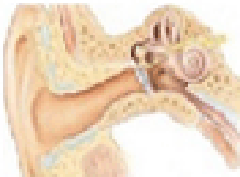How Our Ears Work
|
|
Our ears are transducers in that they change the form of energy. The first change in the form of energy takes place at the tympanic membrane (ear drum) where sound waves are changed from one kind of energy to another. In this case the sound waves (air pressure) are changed into mechanical energy which actuates the ossicular chain, the three small bones of the middle ear. The second change in the form of energy takes place at the oval window which is the membrane that separates the middle ear from the inner ear. The base plate of the stapes (commonly referred to as the stirrup) is attached to the oval window on the middle ear side. On the other side of the oval window is cochlear fluid known as perilymph. With the motion of the stapes against the oval window the mechanical energy of the ossicular chain is changed into hydraulic energy. The third change in energy happens when the cochlear fluid causes the basilar membrane to flex which in turn causes the “hair cells”, which are attached to the basilar membrane at one end and the tectorial membrane at the other, to fire off electrical impulses which are carried out of the cochlea by the eighth cranial nerve and ascend the auditory pathway on their way to the auditory radiations of the temporal lobe of the brain where these electrical impulses are decoded. Everything we hear from music to speech, in fact all sounds, go through these energy changes before they reach the brain where we “hear” them. |
